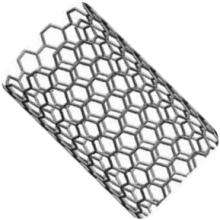New 'doping' method improves properties of carbon nanotubes

(Phys.org) —Yale University researchers have developed a simple method for controlling the "doping" of carbon nanotubes (CNTs), a chemical process that optimizes the tubes' properties. Reported April 29 in Nano Letters, the method could improve the utility of doped CNTs in a number of nanotechnologies and flexible electronics, including CNT-silicon hybrid solar energy cells.
Led by André Taylor of the Yale School of Engineering & Applied Science and Nilay Hazari of Yale's chemistry department, the researchers developed a method that uses organic compounds with a metal core—known as metallocenes—to produce two possible types of doped CNTs.
A small amount of metallocenes in solution is deposited on the CNTs, which are then rotated at high speed. This simple "spin coating" process spreads the solution evenly across the surface of the CNTs, resulting in high doping levels that can improve electrical utility.
Using the method, the researchers found that doping with electron-deficient metallocenes, such as those with a cobalt core, results in CNTs with more positively charged electron "holes" than available negatively charged electrons to fill those holes; these CNTs are known as "p-type" because of their positive charge. On the other hand, doping with electron-rich metallocenes, such as those with a vanadium core, results in thenegatively charged "n-type" CNTs, which have more electrons than holes.
According to the team, which also includes doctoral candidates Xiaokai Li (lead author) and Louise Guard, metallocenes are the first generic family of molecules demonstrated to produce both p-type and n-type doping.
"We showed that by changing the coordinate metal of a metallocene, we could actually render these carbon nanotubes p-type or n-type at will, and we can even go back and forth between the two," said Taylor, who is associate professor of chemical and environmental engineering. Hazari is assistant professor of chemistry.
The finding is significant, Taylor said, because although p-type doping is common and even occurs naturally when CNTs interact with air, previous n-type doping methods produced low doping levels that could not be effectively used in devices. The Yale team's method produced an n-type CNT-silicon cell more than 450 times more efficient than the best solar cells of this type.
"If you have a high doping ratio, then you have better electron transport, better mobility, and ultimately a better functioning device," said Taylor. "As such, these findings move us one step further towards our goal of improving the efficiency of hybrid solar cells."
More information: "Controlled doping of carbon nanotubes with metallocenes for application in hybrid carbon nanotube/Si solar cells." Xiaokai Li, Louise M Guard, Jie Jiang, Kelsey Sakimoto, Jing-Shun Huang, Jianguo Wu, Jinyang Li, Lianqing Yu, Ravi Pokhrel, Gary W. Brudvig, Sohrab Ismail-Beigi, Nilay Hazari, and Andre Taylor. Nano Letters Just Accepted Manuscript. DOI: 10.1021/nl500894h
Journal information: Nano Letters
Provided by Yale University


















